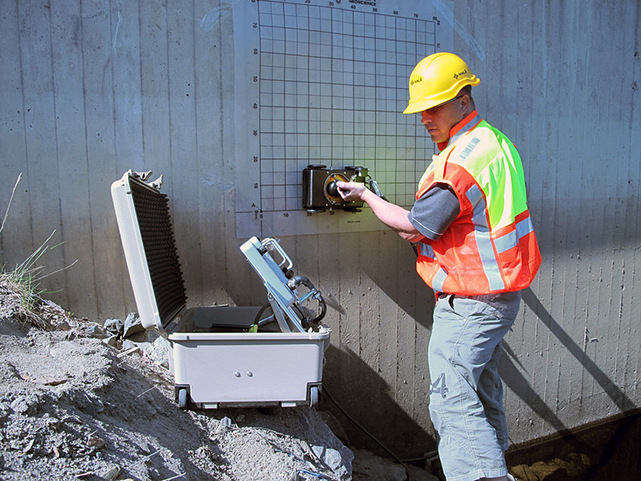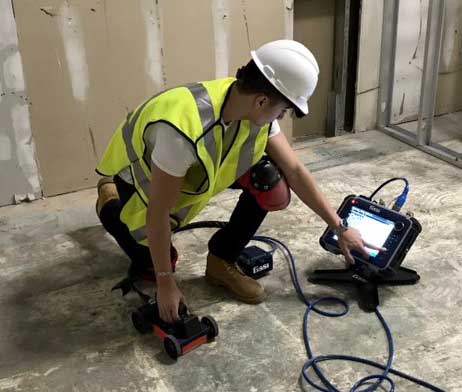Unlock the Key Benefits of Concrete Scanning for Streamlined Workflow and Price Savings
In the realm of construction and infrastructure development, the usage of concrete scanning innovation has actually reinvented job administration techniques. The real worth lies in the nuanced ways in which concrete scanning can transform the landscape of construction projects, leading to structured procedures and significant expense savings.
Improved Project Planning and Implementation
Boosted task preparation and execution are vital components in the successful implementation of concrete scanning technology within building and construction projects. By incorporating concrete scanning into the preliminary job preparing phase, building teams can properly recognize the area of rebar, post-tension wires, and various other embedded objects within concrete frameworks. This details enables more accurate project organizing, reducing the risk of expensive errors or hold-ups throughout the building process.
In addition, with concrete scanning modern technology, job supervisors can develop comprehensive 3D models of the subsurface problems before any kind of boring or cutting takes area. This level of insight enables contractors to make enlightened decisions and changes to their construction strategies, resulting in boosted project performance and overall top quality.
Fundamentally, the assimilation of concrete scanning enhances job preparation by supplying essential information that enhances decision-making procedures, decreases rework, and guarantees that building and construction jobs are finished on time and within budget plan. By leveraging this advanced innovation, building and construction teams can enhance procedures, mitigate dangers, and supply successful results for their customers.

Enhanced Accuracy in Object Discovery
By incorporating concrete scanning technology right into construction jobs, the emphasis moves in the direction of accomplishing increased accuracy in things discovery, particularly in recognizing rebar, post-tension cable televisions, and various other ingrained objects within concrete frameworks. By precisely identifying ingrained items, building and construction teams can stay clear of costly mistakes, revamp, and project delays.
Concrete scanning modern technology allows building professionals to picture the interior make-up of concrete structures in real-time, giving comprehensive understandings into the existence and positioning of things within the concrete. This level of precision not just enhances job preparation and implementation but also lessens the threat of accidents and architectural failures. With improved item detection capacities, building teams can function extra efficiently, reduce material waste, and eventually supply high-quality projects within budget plan and routine restrictions.
Improved Security and Threat Reduction

In addition, concrete scanning aids in guaranteeing the architectural stability of buildings and facilities by detecting spaces, delamination, or various other defects that might endanger the safety of the task. By addressing these problems early on, building groups can take the necessary restorative activities to reinforce the concrete and avoid future troubles. Inevitably, the improved safety and security and danger reduction given by concrete scanning innovation not just safeguard the wellness of employees and the general public but also add to the overall success and longevity of building jobs.
Time Effectiveness and Expense Cost Savings
Carrying out concrete scanning modern technology in building and construction tasks can cause substantial look these up time effectiveness and expense savings. By using advanced scanning tools such as ground-penetrating radar (GPR) and electromagnetic induction, construction groups can properly situate rebar, post-tension cords, and other subsurface elements without the need for destructive approaches. This specific details permits streamlined project preparation and execution, decreasing the time invested on unanticipated delays as a result of striking unidentified items during excavation or drilling.
In addition, the capacity to determine potential dangers underneath the surface ahead of time can stop costly problems to equipment and injuries to employees, additionally contributing to total expense savings. Furthermore, the efficiency obtained from using concrete scanning technology converts into faster task completion times, making it possible for building firms to handle even more jobs and raise their earnings.
Minimized Disturbances and Downtime
The utilization of concrete scanning innovation not only improves time performance and cost financial savings in construction jobs yet also plays an essential duty in minimizing interruptions and downtime. By using advanced scanning techniques such as Ground Passing Through Radar (GPR) or Concrete X-ray, construction teams can properly situate rebar, post-tension cable televisions, channels, and various other subsurface structures within concrete structures without the requirement for devastating investigative methods (RainierGPR Concrete Scanning). This precision in finding essential parts helps prevent unexpected problems throughout exploration, cutting, or coring activities, therefore substantially lowering the risk of unexpected downtime due to repair work or remodel
In addition, concrete scanning makes it possible for project managers to plan construction activities much more efficiently by determining prospective barriers ahead of time. By having a clear understanding of the subsurface problems, building and construction staffs can purposefully browse around critical areas, ensuring smooth progress and minimal disruptions. This proactive approach not just conserves time yet additionally adds to keeping a secure functioning setting for all employees included. Eventually, the reduced disruptions and downtime facilitated by concrete scanning technology lead to boosted task timelines, raised efficiency, and general cost savings for building and construction tasks.
Conclusion
To conclude, concrete scanning supplies many sites benefits for streamlined procedures and cost savings in numerous markets - RainierGPR Concrete Scanning. By enhancing project preparation and execution, increasing precision in item detection, improving safety and security and danger reduction, saving time and expenses, and minimizing interruptions and downtime, companies can optimize their processes and attain greater effectiveness. Overall, integrating concrete scanning into procedures can cause boosted results and a more efficient work atmosphere
By integrating concrete scanning right into the initial job intending phase, building groups can accurately identify the place of rebar, post-tension wires, and other embedded items within concrete frameworks.By incorporating concrete scanning technology into building tasks, the emphasis shifts towards attaining increased accuracy in object discovery, specifically in identifying rebar, post-tension get more wires, and other ingrained objects within concrete frameworks.Concrete scanning modern technology enables building and construction professionals to envision the interior make-up of concrete structures in real-time, supplying detailed insights into the existence and positioning of things within the concrete. By employing innovative scanning techniques such as Ground Penetrating Radar (GPR) or Concrete X-ray, building teams can precisely locate rebar, post-tension cable televisions, channels, and various other subsurface frameworks within concrete structures without the requirement for harmful investigatory techniques. Inevitably, the lessened interruptions and downtime facilitated by concrete scanning technology lead to boosted task timelines, raised performance, and general cost savings for construction projects.
Comments on “Harnessing Innovation: RainierGPR Concrete Scanning for Accuracy Outcomes”